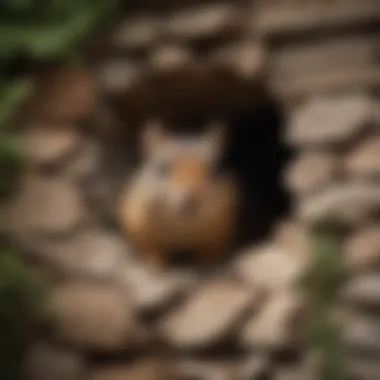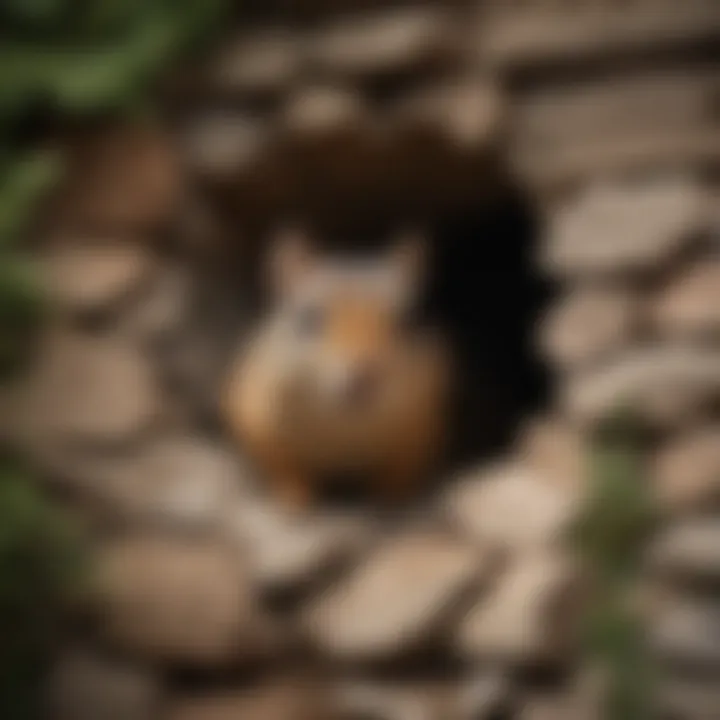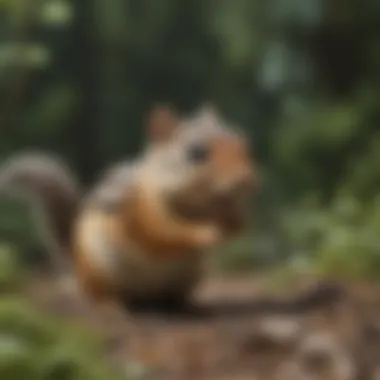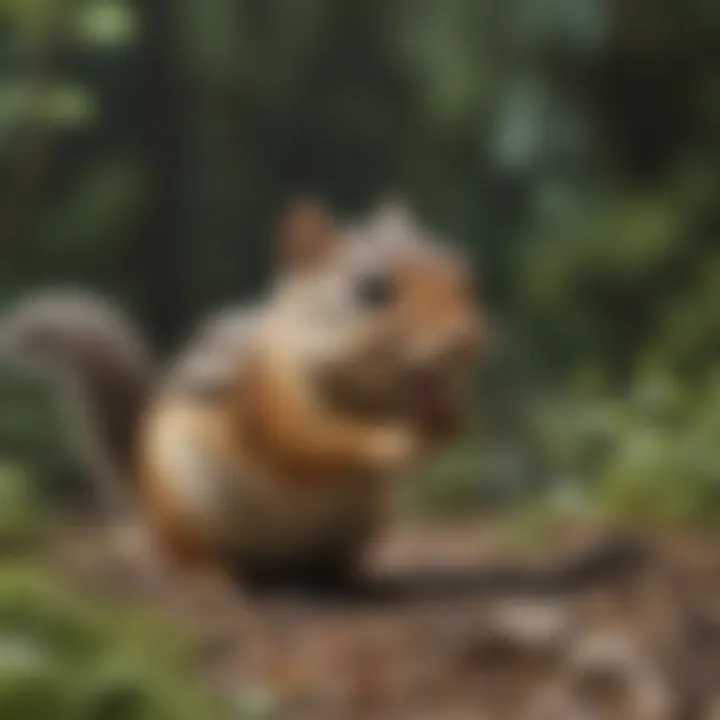Effective Strategies to Catch Chipmunks at Home


Intro
Catching a chipmunk in your house can seem daunting. These small mammals are alert and quick, making encounters tricky. However, understanding their behavior and applying the right strategies can simplify the process. This article will guide you through the best methods for humanely trapping chipmunks, while also sharing preventive measures to minimize their chances of intruding into your home in the first place.
Understanding Chipmunk Behavior
Chipmunks are naturally curious. They often venture into homes in search of food or shelter. Knowing where they are likely to enter will increase your chances of catching them. Look for signs of their activity, such as droppings, gnawed items, or chewed wiring, to pinpoint where they might be hiding. It’s essential to act wisely and promptly, as prolonged infestation can lead to damaged property.
Design Inspiration
While a design theme may not directly seem linked to small pests, creating a home environment that is less inviting to chipmunks involves making strategic design decisions.
Trending Styles
In a home filled with modern amenities, large openings and clutter can attract chipmunks. Opting for a clean, minimalist design can help reduce potential hiding spots and access points. Keep windows and doors fitted with proper screens.
Color Palettes
Choosing earthy tones for your interior can create a balance between nature and comfort. Light browns and greens can help blend your home with the external environment, making it visually friendly yet preventing unwanted small guests from feeling at home as well.
Practical Tips
Maintenance & Care
Regular maintenance of your home can deter chipmunks.
- Seal Entry Points: Inspect your house for any cracks or holes. Seal these immediately. Use materials such as steel mesh or caulking.
- Store Food Properly: Keep all food items, especially pet food and birdseed, in airtight containers.
- Trim Vegetation: Keep shrubs and trees trimmed away from your house. This limits paths for chipmunks to explore.
Budgeting & Planning
Setting aside a budget for pest control can be beneficial. Humane traps can vary in price. Basic models are affordable, but investing in higher-quality traps may offer better results. Prioritize your plan based on your home’s specific needs and chipmunk activity levels.
"Attacking the problem with a structured approach can lead to more successful outcomes."
Trapping Options
When it becomes neccessary to capture a chipmunk, humane traps are the most ethical option. Brands such as Victor and Havahart offer effective solutions. Follow the instructions carefully when setting these traps and monitor them regularly to avoid causing stress or harm to the animals.
By understanding the behavior of chipmunks and employing practical strategies, you can navigate trapping and preventing these animals from intruding into your home in a considerate and sustainable manner.
Understanding Chipmunks
Understanding chipmunks is crucial for any homeowner facing an invasion of these small creatures. Chipmunks can easily become unwelcome guests in homes, especially during certain seasons when they seek food and shelter. Gaining insight into their habits and characteristics makes it easier to devise effective methods for capturing and preventing future intrusions. Moreover, comprehending chipmunk behavior leads to a more humane approach, fostering a respectful nature towards these wild animals.
One key consideration in recognizing and dealing with chipmunks is their adaptability. They can thrive in various environments, which means they might easily enter homes that provide suitable conditions. Identifying them accurately reduces the possibility of confusion with similar species, which can alter trapping and prevention strategies. Additionally, understanding their patterns helps in planning the best time to set traps and the right locations to place them.
Identification of Chipmunks
Chipmunks belong to the family Sciuridae, characterized by their striped backs and petite size. The most common species in North America is the Eastern chipmunk. Their size is typically around 9 to 10 inches long, including the tail, with a distinctive row of stripes: five dark stripes on their back.
The coloration of chipmunks often ranges from brownish-gray to reddish-brown, which can blend with their surroundings. If you notice small, burrowing activities and scattered seeds around your garden or foundation, it's likely a sign that chipmunks are nearby.
To effectively manage their presence, it's helpful to remember the following:
- Physical Traits: Small size with noticeable stripes
- Habitat Preferences: Often found near wooded areas or gardens
- Active Times: Generally active during the day, especially in morning and late afternoon, when they search for food.
Behavioral Patterns
Chipmunks exhibit fascinating behavioral patterns that can aid in your strategies for catching them. They are primarily foragers, with diets mostly consisting of seeds, nuts, fruits, and sometimes insects. This diet often leads them into gardens or near homes where food is readily available.
Their boldness in searching for food can make them more prone to traps, given the right incentives. Typically, chipmunks will make burrows underground that serve as both nesting and storage spaces for their food. Understanding their burrowing habits can provide clues for effective trap placement.
Observe the following behaviors:
- Foraging: Chipmunks actively seek food by digging and caching it.
- Nesting: They create burrows with multiple chambers and exits for safety.
- Communication: They emit a series of chirps and chitters to alert others of danger.
Monitoring these patterns can provide an opportunity to plan your trapping methods more effectively.
Signs of Chipmunk Infestation
Recognizing signs of a chipmunk infestation is crucial for homeowners. Early identification can prevent damages and more extensive problems. Chipmunks may seem harmless, but they can lead to significant issues if not addressed. This section will examine specific indicators that signal the presence of these creatures in your home, enabling you to take appropriate action in a timely manner.
Physical Evidence
Physical evidence of chipmunks is often the first sign that alerts a homeowner. Their small size allows them to access various areas of the house, making detection critical. Here are some common signs:


- Burrows: Chipmunks often dig small holes in the soil around the foundation of your home. This activity is typically indicative of their nesting behavior.
- Chewed Materials: If you find gnawed wood, wires, or even clothing, this may indicate chipmunk activity. These animals have strong front teeth that allow them to easily damage variety of materials.
- Droppings: These are small, dark brown pellets often found near nesting sites or feeding areas. Their presence can confirm that chipmunks are indeed in your living space.
- Footprints: Look for small tracks or trails, particularly in dusty areas or near entry points. The footprints can help you identify their movement.
Being aware of these signs can help you assess the severity of the infestation. If you notice a combination of these factors, it might be time to consider immediate actions to eliminate the problem.
Noise Indicators
Chipmunks can also be detected through sounds they produce in your home. Many homeowners overlook auditory clues, but these can indeed provide insight into their presence. Common noises associated with chipmunk activity are:
- Chirping Sounds: Chipmunks communicate using distinctive chirping sounds, especially if they feel threatened. If you hear persistent chirping, it might indicate the presence of these animals.
- Rustling: Listen for sounds of movement within walls, beneath floorboards, or in attics. Chipmunks may scurry around while searching for food or exploring their environment.
- Scratching Noises: Often heard at night, scratching sounds can signify chipmunks trying to dig or move through spaces in your home.
"Being attentive to noise indicators can complement physical evidence in identifying a chipmunk infestation."
Preparing to Catch a Chipmunk
The process of capturing a chipmunk requires not only the right traps but also a thorough understanding of your unique situation. Preparing properly is crucial. An ill-prepared approach can lead to ineffective trapping or even distress to the animal. This section addresses key elements, benefits, and considerations that should guide homeowners in their chipmunk-catching endeavors.
Assessing Infestation Level
Before proceeding to trap a chipmunk, understanding how serious the infestation is essential. Knowing the infestation level helps in selecting effective methods and ensuring that the chosen traps will accommodate the chipmunks in question.
To assess the infestation:
- Look for Droppings: Chipmunk droppings are small, dark pellets found near nesting sites. Locate these areas, as they often indicate where the animals are residing.
- Observe Activity: Take note of chipmunk activity during the day. Early morning or late afternoon are best for seeing them. Watch for their movements to identify common pathways.
- Check for Damage: Inspect your garden, foundation, or attic for signs of damage caused by the chipmunks. Chewed wires or holes can suggest a more severe issue.
By carefully assessing the infestation level, it's easier to decide on the urgency of your actions. A serious infestation, characterized by notable evidence, might necessitate immediate intervention to prevent damage.
Choosing the Right Time to Act
Timing plays a vital role in successfully capturing chipmunks. It is important to strike when conditions are favorably aligned with your trapping efforts. Here are some considerations to keep in mind:
- Seasonal Changes: Chipmunks are most active during the spring and fall. If possible, it's better to plan your trapping during these seasons when chipmunks are seeking food and preparing for winter.
- Weather Conditions: Rainy or windy days might deter chipmunk activity. Choose dry and calm days for the best chances of successful traps.
- Time of Day: Chipmunks are primarily diurnal animals, so setting traps in the early morning or late afternoon increases your chance of capturing one.
By understanding when to act, you not only increase your chances of a successful capture but also contribute to an efficient and humane approach.
Selecting Traps
Selecting the right trap is a crucial step in the process of capturing a chipmunk in your house. It requires understanding both the behavior of chipmunks and the options available in the market. Using the right trap can enhance your chances of a successful capture while ensuring safety for both the animal and yourself.
There are various factors to consider when selecting traps. One should think about the size of the chipmunk, the location of the trap, and the level of human intervention you are comfortable with. Traps vary in design and function from simple to complex, and choosing the correct one can make all the difference.
Types of Traps Available
When it comes to trapping chipmunks, there are several types of traps to consider:
- Live traps: These are designed to catch chipmunks without harming them. They are generally easy to use, but require monitoring to ensure the trapped animal does not suffer. Common models include the Havahart and Tomahawk traps.
- Snap traps: These traps kill the animal quickly upon capture. While they are effective, they require a level of caution and may not be suitable for everyone. Brands like Victor provide popular options in this category.
- Electronic traps: These are a modern solution that uses a high-voltage shock to quickly kill the chipmunk. They typically require batteries and can be more expensive. However, they are effective and offer a more humane kill.
When deciding which trap is best, think about the practicality and the ethics involved.
Humane vs. Non-Humane Traps
The choice between humane and non-humane traps is an important consideration in any trapping process. Humane traps are designed to capture the animal alive without causing harm. This allows you to relocate the chipmunk to a suitable environment without causing distress.
On the other hand, non-humane traps, particularly snap traps, aim to kill the animal immediately. While they can be effective, they carry ethical implications and may not align with everyone's values.
When deciding between these options, consider the following factors:
- Ethics: If you value humane treatment of animals, live traps may be preferable.
- Effectiveness: Non-humane traps often have immediate results but might lead to suffering if not monitored closely.
- Local regulations: Some areas have specific laws concerning trapping, and it's essential to be aware of these.
Ultimately, choosing the right trap involves balancing effectiveness, ethics, and your own comfort with handling potential animal captures.
Setting the Trap
Setting the trap is a critical phase in the process of catching a chipmunk. This stage encompasses various considerations that can significantly influence the success of capturing the animal. An effective trapping setup takes into account the best location, appropriate bait, and proper techniques for placement. Understanding these elements will not only enhance the odds of capturing a chipmunk but also ensure that the entire process is conducted in a humane manner.
Location Considerations
Choosing the right location for the trap is vital. Chipmunks tend to thrive in environments that provide shelter and access to food sources. Look for spots around your house that reveal signs of chipmunk activity, such as droppings or burrows. Common areas to set traps include:
- Near entry points like doors or windows where chipmunks might enter.
- Close to food sources, such as gardens or bird feeders.
- Along the pathways where they frequently travel or hide.
Additionally, avoid placing traps in open areas where they may easily be disturbed by pets or children. It is essential for traps to be camouflaged somewhat, so they blend into the surroundings. This can make chipmunks less suspicious of their presence.
Bait Options
Selecting the right bait can determine the trap's effectiveness. Chipmunks are drawn to a variety of food items, especially those that are familiar to them. Suitable bait options to consider include:
- Sunflower seeds: These are highly attractive to chipmunks and are often used in various traps.
- Peanuts: A favorite snack, peanuts can attract chipmunks when placed inside the trap.
- Fruits: Small pieces of apple or banana can also entice them due to their sweetness.


When placing bait inside the trap, ensure that it is securely attached, so the chipmunk must work to get it, triggering the trap mechanism. This increases the chances of a successful capture.
Trap Placement Techniques
The manner in which the trap is placed can enhance its chances of success. Here are several techniques to consider:
- Position traps parallel to walls or structures that chipmunks explore. This encourages them to enter the trap more naturally.
- Keep traps low to the ground, as chipmunks are not high jumpers and feel safer close to their usual foraging heights.
- Avoid moving the trap once it is set, unless there are no captures after a reasonable time.
It is advised to regularly check your traps, as leaving them unattended may lead to unnecessary suffering for the animal.
By carefully considering the location, bait options, and trap placement techniques outlined above, homeowners can significantly improve their chances of successfully trapping chipmunks while ensuring humane treatment throughout the process.
Monitoring the Trap
Monitoring a trap set to catch chipmunks is essential for multiple reasons. First, it ensures that the trap operates effectively and safely. Regular checks help to confirm whether it is functioning as designed, which is crucial for humane trapping methods. If the trap is not triggered for an extended period, it may indicate an issue, such as improper placement or ineffective bait.
Second, the frequency of checks can significantly affect the wellbeing of the animal. Chipmunks can become agitated or stressed if they are left in a trap for too long. Observing the situation closely minimizes their suffering and aligns with ethical trapping practices. It also helps in avoiding unwanted situations, such as a captured chipmunk being exposed to extreme weather conditions.
Lastly, monitoring the trap allows the homeowner to assess the effectiveness of the strategies employed. This can lead to better decision-making in terms of trap adjustments or bait changes to increase the likelihood of capture.
"A proactive approach ensures effective and humane trapping of chipmunks. Regular monitoring plays a key role in both animal welfare and successful capture."
Frequency of Checks
The frequency of checks should primarily depend on the type of trap used and the local climate. For instance, if using a live trap, it is advisable to check it every few hours, especially in warmer weather. Longer intervals may lead to distress for the animal captured. In colder weather, checks can be slightly longer, but they should still be performed at least twice a day.
In fragile environments where other wildlife may be present, a more frequent check could help avoid unintended captures or fatalities. The general rule is that more frequent checks are better for both ensuring the trap’s functionality and maintaining the wellbeing of any captured chipmunk.
Recognizing Successful Captures
Recognizing a successful capture involves understanding how the trap indicates it has caught an animal. Most traps will have a mechanism that activates when the chipmunk enters, shutting the door or pausing the trigger. Additionally, observing the bait can provide clues. If the bait is missing but the trap has not engaged, it likely means the chipmunk has taken the food without triggering the trap.
When checking the trap, assess the captured chipmunk for signs of stress. A chipmunk that confronts the situation calmly may have been caught recently. Conversely, a visibly agitated or distressed chipmunk could suggest a longer period of captivity.
When confirming success, one must ensure the trapped chipmunk is safe before proceeding to transport it for release, as managing their wellbeing is of utmost importance.
Handling Captured Chipmunks
Proper handling of captured chipmunks is crucial not only for the safety of the animals but also for the well-being of individuals who may encounter them. This stage is often neglected, yet it determines the effectiveness of your entire trapping effort. Recognizing how to handle these animals can minimize stress on them, ensure humane treatment, and facilitate a smooth transfer back to their natural habitat. This section will cover the immediate steps to take after capturing a chipmunk, focusing on safe transportation and diverse release strategies.
Safe Transportation
Transporting a captured chipmunk necessitates careful consideration. The primary goal is to ensure the chipmunk remains calm during the journey, which reduces stress and the risk of injury.
- Selection of a Transport Container: Use a sturdy, well-ventilated trap, specifically designed for chipmunks. Ensure it is secure and has no sharp edges.
- Minimizing Disturbance: Cover the trap with a blanket or towel. Darkening the environment can calm the animal, mimicking the safety of its burrow.
- Handle with Care: Transport the trap by holding it from the base. Avoid jerking movements.
- Environmental Considerations: Keep the trap away from direct sunlight and extreme temperatures to avoid overheating. Transporting during cooler times of the day may help.
The safety of the chipmunk during transportation is paramount. A stressful journey can have long-term impacts on its health and ability to adapt when released.
Release Strategies
Releasing the captured chipmunk is an essential step that requires thoughtful planning. Here are key aspects to consider:
- Choosing the Right Location: Ideal release points are far enough from your home to prevent repeat visits. A local park or wooded area is preferable. The spot should have adequate cover and food sources.
- Timing of Release: Early morning or late afternoon can be ideal; chipmunks are often more active during these times. This maximizes their chances of quickly adapting to their new environment.
- Gentle Release Technique: Open the trap door slowly and allow the chipmunk to exit on its own. Patience during this process respects the animal’s instinct to retreat initially, allowing it to scan for potential dangers.
- Observation: After release, quietly observe from a distance. Ensure the chipmunk appears healthy and moves away from human habitation.
In some cases, confirming that the animal has integrated smoothly can be beneficial. Ultimately, proper release strategies contribute to maintaining a balance in the local ecosystem, promoting a humane approach to managing wildlife.
"Humane treatment of captured animals not only safeguards their well-being but also fosters a respectful interaction with nature."
By focusing on both transportation and release techniques, homeowners can effectively manage chipmunk encounters while embodying responsible wildlife practices.
Preventing Future Chipmunk Problems
Preventing future chipmunk problems is crucial for every homeowner who has dealt with these creatures. The impact of a chipmunk invasion can extend beyond mere annoyance. Infestations can lead to property damage and create potential health risks. Thus, understanding how to mitigate the chances of chipmunks intruding is a wise investment of time and resources.
By taking proactive measures, homeowners can discourage chipmunks from entering their homes. Effective prevention strategies will save time and reduce the costs associated with trapping and repairing damage caused by their presence. Additionally, these methods can create a more pleasant living environment. Prevention ensures peace of mind knowing that you've taken the necessary steps to protect your home.
Identifying and Sealing Entry Points
Identifying and sealing entry points is the first step in preventing chipmunk problems. Chipmunks are small and agile, capable of fitting through small gaps. Common areas where chipmunks enter include:
- Cracks in foundations
- Gaps around windows and doors
- Vents and ducts not properly screened
- Openings where utilities enter the home
Inspect your home regularly. Look for any small holes or cracks that might be overlooked. It is also helpful to observe any areas where you notice chipmunk activity. Once identified, sealing these entry points using materials like steel wool or caulk can effectively deter future intrusions. In particular, steel wool is useful as it is difficult for chipmunks to chew through.
Long-term Deterrence Methods


Long-term deterrence methods are also valuable in maintaining a chipmunk-free home. These strategies often include:
- Landscaping Adjustments: Chipmunks are attracted to gardens and flower beds. Keeping these areas well-maintained can help. Trimming back shrubs and trees prevents them from making nests close to your house.
- Removal of Food Sources: Ensure that pet food is stored properly. If bird feeders are used, consider placing them in locations less accessible to chipmunks.
- Utilizing Natural Repellents: Certain scents can deter chipmunks. Applying spicy pepper sprays or using predator urines can create an adverse environment for them.
- Routine Maintenance: You should routinely check all sealing and barriers to ensure they remain intact. Regular maintenance does not only keep entry points sealed but also limits allure.
Effective prevention measures minimize the risk of chipmunks invading your living space, thus preserving your home's safety and comfort.
By implementing these strategies, you not only reduce the chances of chipmunks entering your home, but also contribute to a more harmonious outdoor environment.
Legal and Ethical Considerations
When dealing with chipmunks in your home, understanding the legal and ethical considerations is crucial. These aspects inform how one should proceed with trapping, handling, or relocating these small creatures. Ignoring these factors can lead to unintended legal consequences, animal welfare issues, and conflicts with local regulations.
Local Wildlife Laws
Each region has specific wildlife laws that govern how homeowners can interact with local fauna, including chipmunks. It is essential to research local regulations before taking any action. Various jurisdictions might have rules on:
- Trapping methods: Some areas may require you to use humane traps or may ban certain trapping techniques altogether.
- Permits: You might need a permit for trapping or relocating wildlife, especially if the species is protected.
- Legal penalties: Violating wildlife laws can result in fines or other repercussions.
Always check with local wildlife agencies to understand the responsibilities and restrictions that apply in your area. This step ensures you conduct your efforts legally and responsibly.
Ethics of Animal Trapping
Beyond legalities, ethical considerations are paramount when trapping chipmunks. Considering the welfare of the animals you are dealing with reflects your values as a homeowner and a society member. Here are some key points to consider:
- Humane traps: Opt for traps that do not cause undue suffering. Humane traps allow you to catch live animals without injurious consequences.
- Relocation: If relocating, ensure the area is suitable and safe for chipmunks. Placing them in an environment where they can thrive is crucial. However, also consider whether this practice may conflict with laws or lead to stress for the chipmunks.
- Impact on ecosystem: Understand that removing chipmunks might disrupt the local ecological balance. Chipmunks play a role in the ecosystem, so be aware of potential consequences.
In summary, navigating the legal and ethical landscape of chipmunk trapping requires careful consideration. By adhering to wildlife laws and embracing humane practices, homeowners can effectively manage chipmunk intrusions while minimizing harm to the animals and the environment. It is a thoughtful approach that underscores the balance between human needs and wildlife welfare.
When to Seek Professional Help
Determining when to seek professional help for a chipmunk problem is crucial for effective resolution. Chipmunk infestations may vary in intensity. While some homeowners may handle minor occurrences independently, others may encounter severe issues requiring expert intervention. Recognizing the signs of a critical infestation is vital in avoiding property damage and health risks.
Identifying Severe Infestations
Severe chipmunk infestations may present several telltale signs. It is essential to monitor your surroundings closely. Here are some indicators:
- Increased activity: When you consistently observe chipmunks during the day, it may indicate a larger colony.
- Nesting behavior: Finding nests or burrows near your home suggests they are settling in.
- Structural damage: Noticing gnaw marks on wood, insulation, or wires can be an alarming sign, as this damage can lead to costly repairs.
- Health concerns: Rodents can introduce pathogens. If you notice unusual droppings or debris, this is a significant cause for concern.
If you experience any of these signs, it is better to take action sooner rather than later. Addressing an infestation at its early stages can save time, effort, and money.
Choosing a Pest Control Professional
When you decide to opt for professional assistance, it is essential to choose the right pest control expert. Here are some factors to consider:
- Experience with wildlife: Look for a professional specializing in humane trapping and handling of chipmunks.
- Local regulations: Professionals should be familiar with wildlife laws in your area. Choose someone who understands what traps and methods comply.
- Reputation: Reading reviews or getting recommendations can lead you to proficient pest control services. Always check customer feedback to ensure their effectiveness.
- Humane practices: Ensure that the professional uses humane methods, minimizing stress and harm to the chipmunks. This aligns with ethical considerations when dealing with wildlife.
Understanding Chipmunk Impact on Homes
Chipmunks, although often seen as cute and harmless, can significantly affect homeowners. Understanding their impact is crucial. Chipmunks can cause property damage and potential health risks, making it important to assess and address any infestation promptly.
Damage to Property
Chipmunks can be surprisingly destructive. A primary concern is their tendency to gnaw. They may target wires, insulation, and even wooden structures. This behavior is not just a nuisance; it can lead to expensive repairs. Here are some specific areas where damage may occur:
- Wiring: Chipmunks often chew through electrical wires. This can create fire hazards or cause electrical problems.
- Insulation: They may disrupt insulation in attics or walls, leading to increased energy costs.
- Foundation: Chipmunks burrow, which can compromise the ground under your home. This may result in structural issues over time.
- Landscaping: They can wreak havoc in gardens, digging up bulbs and seedlings in pursuit of food.
Being informed about these risks can help homeowners make proactive decisions. Preventative measures such as sealing entry points and regular inspections can mitigate potential damage.
Potential Health Risks
In addition to physical damage, chipmunks pose several health risks. Although they are not known to transmit diseases as frequently as other rodents, they can still be carriers of parasites and pathogens. Here are key considerations:
- Parasites: Chipmunks can carry fleas, ticks, and mites. These pests may invade your home, leading to infestations.
- Contaminated Droppings: Their droppings can contaminate surfaces, leading to health hazards if not cleaned properly.
- Allergens: Rodents can trigger allergies in sensitive individuals, causing respiratory issues or other allergic reactions.
"Understanding the risks associated with chipmunk infestations can assist homeowners in taking the right steps to protect their health and property."
Overall, the impact of chipmunks in homes is significant. Recognizing the potential damage and health risks allows homeowners to act effectively, ensuring that their living environment remains safe and secure.
Key Takeaways
In examining the matter of catching chipmunks in your home, the importance of effective strategies becomes evident. These strategies not only facilitate the removal of these creatures but also contribute to a broader understanding of how to manage wildlife interactions in a responsible manner. Homeowners must appreciate the specific considerations involved in addressing chipmunk infestations, ensuring both humane treatment and effective resolution.
Summary of Effective Strategies
To summarize the effective strategies for catching chipmunks, it is crucial to adopt a systematic approach. This begins with understanding their behavior and identifying signs of an infestation. Homeowners should look for physical evidence and listen for noise indicators. Once identified, the next step is to prepare adequately, selecting the right traps based on personal preference and ethical considerations.
Effective strategies include:
- Selecting the Right Trap: Choose between humane and non-humane traps according to your values and local regulations.
- Optimal Trap Placement: Traps should be placed in areas where chipmunks are frequently observed or near their entry points.
- Baiting Techniques: Use appealing bait such as nuts or seeds to attract the chipmunks.
- Regular Monitoring: Check traps frequently to ensure any captured animals are treated humanely.
"The use of humane traps promotes ethical practices while effectively managing wildlife disturbances."
By synthesizing these elements, homeowners are better equipped to manage chipmunk issues efficiently and considerately. It is essential to remember that beyond just capturing a chipmunk, the overarching goal is to maintain a sustainable and chipmunk-free living environment.















